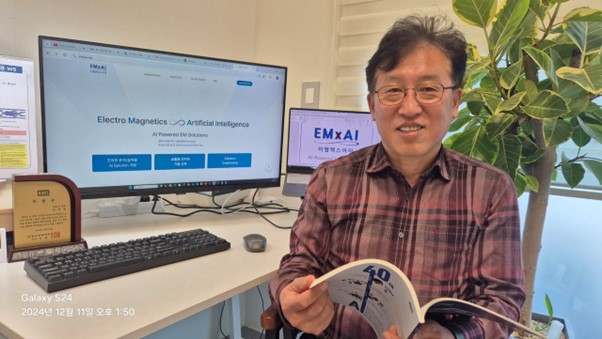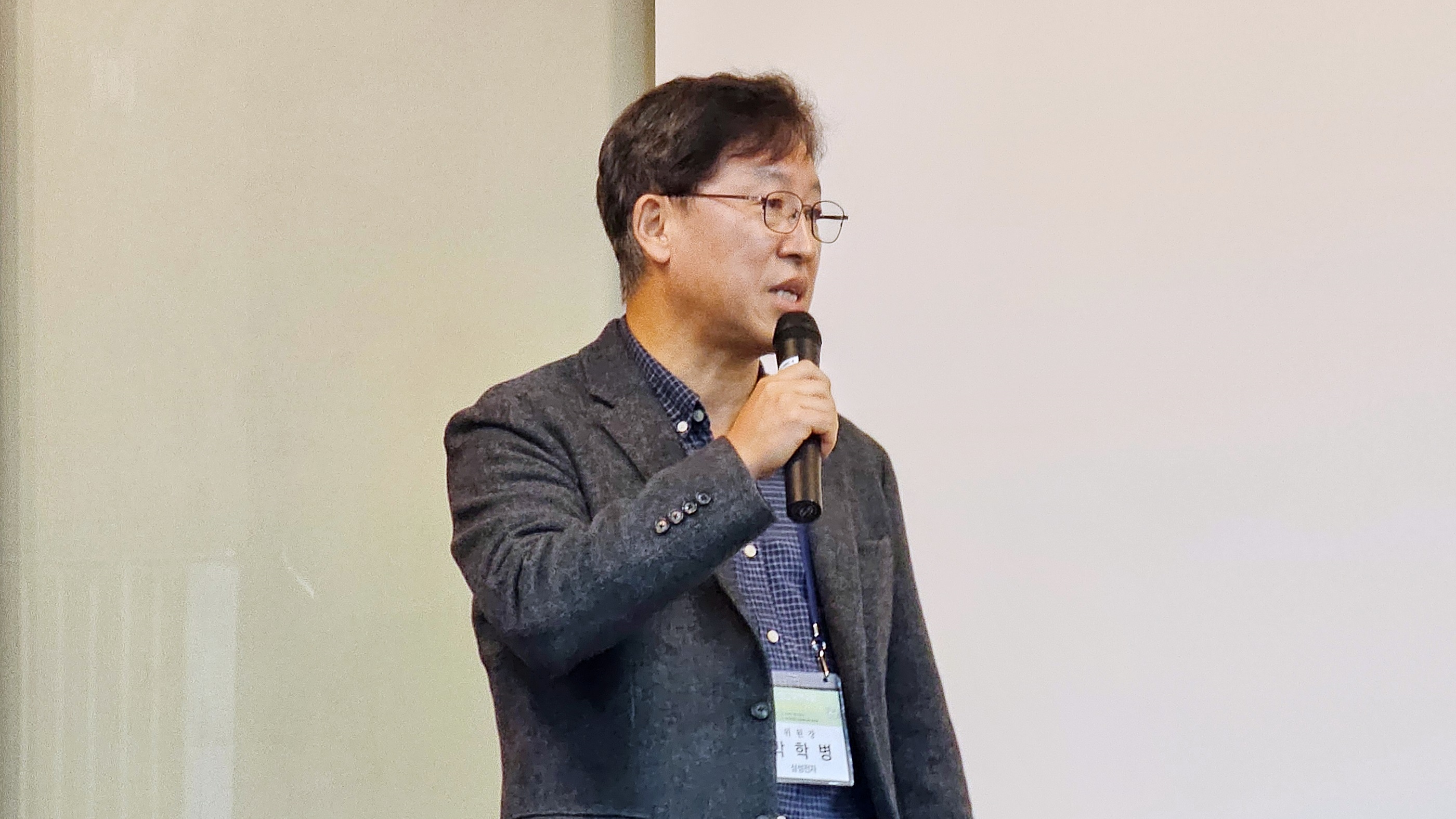[편집자주] 전자파 분야에서 AI 융합 발전이 빠르게 이뤄지고 있다. AI 기술이 전 산업 분야에 융합되기 시작하면서 EMI/EMC 분야에서도 AI 기술 도입 논의 및 연구가 활발하게 진행되고 있다. 이에 EM엔지니어와 미래 기술자들을 위한 AI 활용과 교육이 중요해질 것으로 기대되는 가운데 이번 ‘EMI/EMC 명사(名士) 대담’에서는 전자파와 AI 융합을 주제로 관련 전문가를 만나 이야기를 나눴다.
최근 이엠엑스아이(EMxAI)를 통해 새로운 시작을 준비하는 박학병 대표를 만나 EMI/EMC 전망과 AI 융합 추세에 대한 이야기를 나눴다.

▲박학병 EMxAI 대표
AI·코드 몰라도 엔지니어 전자파설계, 분석에 AI 활용
시뮬레이션 한계 보완하는 물리기반신경망 도입 기대
EMxAI, AI 활용 전자파 솔루션·전자파기술 교육 지원
[편집자주] 전자파 분야에서 AI 융합 발전이 빠르게 이뤄지고 있다. AI 기술이 전 산업 분야에 융합되기 시작하면서 EMI/EMC 분야에서도 AI 기술 도입 논의 및 연구가 활발하게 진행되고 있다. 이에 EM엔지니어와 미래 기술자들을 위한 AI 활용과 교육이 중요해질 것으로 기대되는 가운데 이번 ‘EMI/EMC 명사(名士) 대담’에서는 전자파와 AI 융합을 주제로 관련 전문가를 만나 이야기를 나눴다.
최근 이엠엑스아이(EMxAI)를 통해 새로운 시작을 준비하는 박학병 EMxAI 대표를 만나 EMI/EMC 전망과 AI 융합 추세에 대한 이야기를 나눴다.
[기자] 간단한 자기소개 부탁드립니다.
[박학병 대표] 저는 1992년에 LG전자에 입사해 삼성전자를 거쳐 약 32년간 가전과 통신제품에 필요한 전자파(EMC, SI, PI) 설계 및 분석방법을 개발하는 일을 해왔습니다. 올해 10월에는 이엠엑스아이(EMxAI)를 설립해 활동하고 있습니다.
아울러 전자파학회 전파교육연구회 위원장을 2023년에 맡아서 전자파 실무자와 대학원생의 역량향상을 위한 학회 활동을 같이 해오고 있습니다.
[기자] 많은 활동들 하고 계실 텐데 근황이 궁금합니다.
[박학병 대표] 올해는 전자파학회 연구회 활동과 창업준비로 유난히 바쁜 한 해 같습니다. 연초에 ‘전자파기술과 AI융합’이라는 주제로 한국전자파학회 전파교육연구회 Workshop2024를 개최했습니다. 이후 강연 요청들이 많았고, 최근에 전자파학회 전자파기술지 편집을 마지막으로 24년 전파교육연구회 활동을 마무리했습니다.
지금은 오랜 기간 몸담았던 대기업 연구원 생활을 정리하고, 개인 회사를 설립해 빌드업에 집중하고 있습니다.

▲(왼쪽)2024 EMC 세미나에서 발표하는 박학병 대표, (오른쪽) 전자파기술지
[기자] 전자파와 AI 융합에 대해 꽤 오랫동안 관심을 갖고 연구하신 것으로 압니다. EMC 분야에서 AI 기술 융합 추세는 어떤가요?
[박학병 대표] EMC기술은 90년대 중반까지 실물을 제작해 실험을 통해 검증·개선하는 방식으로 진행이 됐습니다. 이후에 20년 이상 시뮬레이션, 지식기반 설계검증시스템(Design Rule Check System)과 같은 방법을 이용하는 틀에서 최근까지 활용되고 있죠.
전자파기술에도 몇년 전부터 AI기술이 도입되기 시작했고, 최근에는 거대언어모델(LLM)을 비롯한 다양한 AI기술이 확대 도입되는 추세에 있습니다.
초기에는 레이더, 안테나 방사특성과 같이 이미지로 특성을 분석하는 영역에 CNN( Convolutional Neural Network)과 같은 AI가 주로 활용이 됐으며, 이후 PCB 전원공급네트워크 설계와 같은 PCB 최적설계 등의 다양한 분야에 강화학습 등이 활용되고 있습니다.
특히 금년 8월, 미국 피닉스에서 개최된 EMC/SI Symposium2024에서는 LLM을 이용한 학술 논문이 발표되고, 강연이 진행되어 주목을 받았습니다.
이런 연구들은 미국 MST(Missouri Science& Technology) EMCLab, 중국 Zhejiang University의 Erping Li교수 Lab을 비롯한 연구실들을 선두로 활발히 진행되고 있습니다.
[기자] 생성형 AI 붐이 일면서 전자파 분야에도 LLM 도입이 화두가 되고 있나요?
[박학병 대표] 2022년 ChatGPT-3.5가 공개된 후 LLM 기반 생성형 AI의 등장은 전자파기술분야에서 AI활용의 중요한 부분으로 작용하고 있습니다. 다른 분야와 마찬가지로 전자파기술분야에 LLM 기반의 AI 적용 가능한 영역이 확대되고, 성능도 급속히 향상되고 있습니다.
이에 AI와 컴퓨터언어에 익숙하지 않은 엔지니어가 전자파설계, 분석에 AI를 활용할 수 있는 길을 열어주고 있습니다.
초기에 chatGPT-3.5로는 간단한 패치(Patch) 안테나를 설계하고, 분석하는 작업도 여러 차례의 시행착오를 거쳐 어렵게 가능했습니다. 현재는 2X2 어레이(Array) 안테나를 설계하고, 특성을 시뮬레이션해 결과를 리포트로 작성하는 것도 간단히 할 수 있습니다.
[기자] 관련해 향후 전망은 어떻게 보시나요?
[박학병 대표] LLM을 이용해 AI기술을 쉽게 활용할 수 있다는 점을 더욱 주목해야 합니다.
예를 들어 어레이 안테나의 전자파 특성을 AI로 자동 Pass, Fail을 평가하는 문제를 가정하겠습니다. 이 경우 Alexnet과 같은 기존의 AI모델을 안테나의 Pass, Fail이 가능한 모델로 학습하는 것이 필요하며, 이것을 트랜스퍼 러닝(Transfer Learning)이라고 합니다.
AI 지식과 프로그램 능력이 필요해 관련 분야에 대한 지식이 충분하지 않은 경우는 실행이 어려운 일인데, LLM을 통해 해당 지식이 부족해도 실행 가능합니다.
이미 LLM은 AI와 컴퓨터 언어에 대한 학습을 통해 지식이 축적돼 있으며, 트랜스퍼 러닝에 필요한 데이터와 간단한 텍스트 명령을 입력하면, 트랜스퍼 러닝을 위한 코드를 쉽게 만들 수 있습니다.
이미 구글 CEO는 회사에서 제작되는 프로그램의 25% 이상이 AI 코딩으로 작성된다고 최근에 밝혔습니다. 아직은 시작단계라 멀리있는 것처럼 느껴지겠지만, 장기적으로는 셰프가 레시피와 재료를 주면 AI가 번거로운 요리작업을 하는 것처럼 도면, 사양, 데이터를 제시해 주면 복잡한 전자기파 설계 및 해석 업무를 자동으로 수행해 주는 형태로 발전할 것으로 기대됩니다.
[기자] EMI/EMC 분야에서는 미래 전망은 어떻게 보시나요?
[박학병 대표] 제품의 융복합화와 무선기능 채용 확대 추세에 따라 제품 내 부품간 무선주파수 간섭(RFI) 방지를 위한 디지털 노이즈 억제 기술이 중요하여 졌습니다. 또한 모바일 제품에서의 저전력·소형화와 같은 휴대성 강화 추세에 따라 정전기 방전대책설계(ESD) 기술도 비중이 높아졌습니다.
신호 전송 속도의 고속화 추세는 EMC와 함께 신호 무결성(SI) 기술도 필수적인 영역이 됐고, 기술을 필요로 하는 제품이 확대되고 있는 상황입니다. 최근에는 폴더블·플렉서블 등 새로운 폼팩터가 등장하면서, 단순히 신호 전송 속도를 높이는 것만이 아니라 접히고 펼쳐지는 구조에 대응해 동일한 전자파·신호 특성을 확보하는 것이 추가적인 과제로 떠올랐습니다.
예컨대 폴더블 기기의 경우 제품이 접혔을 때와 펼쳤을 때 신호가 통과하는 회로(인터커넥트) 특성이 달라져, 모든 상태에서 일정한 임피던스와 전자파 방출 특성을 유지해야 하는 복합적 도전 과제가 생기는 것입니다.
앞으로 전자파 기술은 이러한 제품 변화를 반영해 계속 발전할 것으로 보이며, 더불어 분석 시간, 예측 오차, 복잡한 활용 등 기존 시뮬레이션 기술의 한계를 보완하기 위해 Physics와 Neural Network를 상호보완 하는 물리기반신경망(PINN)과 같은 다양한 AI 기술이 적극적으로 도입될 것으로 기대됩니다.

▲박학병 대표
[기자] 최근 창업을 하셨습니다. 어떤 회사인지 소개 부탁드립니다.
[박학병 대표] 이엠엑스아이(EMxAI)라는 사명으로 회사를 설립했습니다. EMxAI는 전자파기술(EM, Electromagnetic)과 인공지능(AI, Artificial Intelligence)의 융합(x)을 의미합니다.
전자파기술을 효율적으로 구현할 수 있는 AI 솔루션 개발과 회로개발자와 전자파기술자의 역량을 확장하고 증강할 수 있는 AI 활용 전자파기술 교육이 주요 사업영역입니다.
이를 통해 전자, 통신, 자동차 및 방산 등 전자파기술이 필요한 산업 분야의 AI기반 설계·분석을 위한 시뮬레이션을 제공하고, 관련 종사자들의 역량 향상에 기여하는 것을 목표로 하고 있습니다.
현재 한국전파진흥협회(RAPA), 한국정보통신기술협회(TTA) 산하 교육기관들과 교육과정 개발 협력을 시작해, 2025년 하반기부터는 관련 교육을 제공할 예정입니다. 장기적으로는 전자파 설계·분석용 AI 솔루션을 개발해 AI를 활용한 전자파 설계·분석 솔루션을 제공할 계획입니다. 기존의 설계·측정 장비들과 연동하는 방향으로 준비하고 있습니다.
[기자] 앞으로의 활동과 계획에 대해 한 말씀 부탁드립니다.
[박학병 대표] 전자파기술의 AI 활용 방향을 구체화하고 관련 기술의 저변 확대를 위해 전자파학회를 중심으로 워크숍을 개최할 계획입니다. 대학원생과 실무자들을 위한 이론 및 실습 교육과정을 개발하는 데 참여해 학회 활동을 이어갈 예정입니다.
아울러 2025년 하반기부터는 소규모 AI 솔루션들을 개발해 회사 웹사이트를 통해 공개할 예정이며, 회사 설립 초기인 만큼, 내년에는 학회 활동보다 회사를 통한 실질적인 활동에 주력하고자 합니다.
[기자] 마지막으로 독자 여러분께 한 말씀 부탁드립니다.
[박학병 대표] EMxAI를 궤도에 올리는 것이 단기 목표입니다. 25년에는 체계적인 AI 기반 전자파 설계, 분석 교육을 개발해 실무자와 대학원생들에게 제공하고, 이어 전자파 설계, 분석에 활용할 수 있는 AI 솔루션을 개발해 활동을 본격화하려고 합니다.
이를 통해 우리 전자파 산업의 경쟁력 확보에 기여할 수 있도록 노력하겠습니다. 다가오는 2025년에는 전자파기술을 하시는 모든 분들이 행복하고, 건강하시길 바랍니다.
감사합니다.


